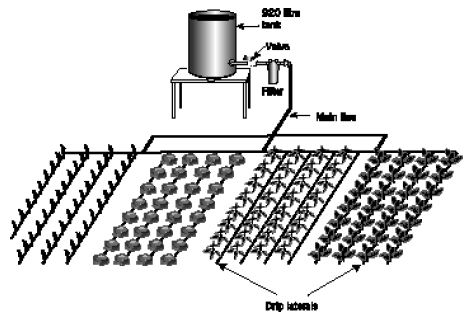Difference between revisions of "Plastro system"
| Line 3: | Line 3: | ||
__NOTOC__ | __NOTOC__ | ||
The Plastro system was developed in Israel as a low-pressure drip irrigation system with high water efficiency, clogging resistance and durability. For further information contact [http://www.efronim.org.il/db/showcomp.pl?comp=Plastro+Gvat Plastro GVAT] in Israel, or ATIF (K) Limited. | The Plastro system was developed in Israel as a low-pressure drip irrigation system with high water efficiency, clogging resistance and durability. For further information contact [http://www.efronim.org.il/db/showcomp.pl?comp=Plastro+Gvat Plastro GVAT] in Israel, or ATIF (K) Limited. | ||
| + | |||
| + | '''Uses of a drum system'''<br> | ||
| + | |||
| + | A drum system covering 5 beds each 1 m wide and 15 m long can be used to grow 250 plants (tomato, egg plant and similar plants requiring a spacing of 60 cm along the plant rows); 500 plants (spinach, cabbage, kale, pepper and similar plants requiring a spacing of 30 cm along the plant rows); or 1,500 plants (onion, carrot and similar plants requiring a spacing of 10 cm). The drum system also offers water storage and control through a control valve, making it possible to fill the drum for irrigating at another time. | ||
| + | |||
| + | Six examples are presented: the KARI drum system from Kenya, the Waggon Wheel system from South Africa, the Family, Plastro and Micro-Tal systems from Israel, and the IDE drum used in India. | ||
==Construction, operations and maintenance== | ==Construction, operations and maintenance== | ||
Revision as of 23:10, 12 May 2013

The Plastro system was developed in Israel as a low-pressure drip irrigation system with high water efficiency, clogging resistance and durability. For further information contact Plastro GVAT in Israel, or ATIF (K) Limited.
Uses of a drum system
A drum system covering 5 beds each 1 m wide and 15 m long can be used to grow 250 plants (tomato, egg plant and similar plants requiring a spacing of 60 cm along the plant rows); 500 plants (spinach, cabbage, kale, pepper and similar plants requiring a spacing of 30 cm along the plant rows); or 1,500 plants (onion, carrot and similar plants requiring a spacing of 10 cm). The drum system also offers water storage and control through a control valve, making it possible to fill the drum for irrigating at another time.
Six examples are presented: the KARI drum system from Kenya, the Waggon Wheel system from South Africa, the Family, Plastro and Micro-Tal systems from Israel, and the IDE drum used in India.
Construction, operations and maintenance
System components
- 920-litre plastic water tank
- Screen filter (120 mesh)
- Control valve
- 24 m x 32 mm PE pipe
- 2 x 32 mm bends
- 2 x 32 mm equal tees
- 16 dripline start connectors
- 16 dripline end closures
- 600 m standard 16 mm drip tube.
Reference manuals, videos, links
Acknowledgements
- Sijali, Isaya V. DRIP IRRIGATION: Options for smallholder farmers in eastern and southern Africa. RELMA, 2001.
